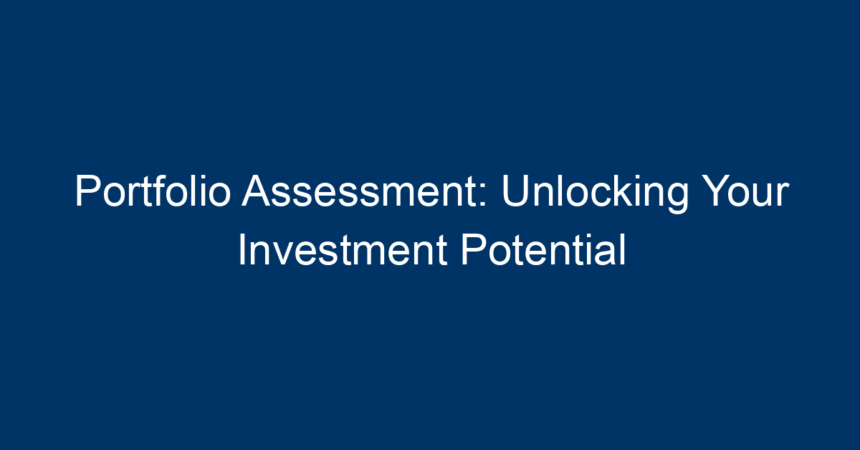Investing can often feel like navigating a complex maze. With numerous asset classes, market trends, and financial strategies to consider, how do you ensure your portfolio is performing at its best? The answer lies in one crucial process: portfolio assessment. This article delves into the intricacies of portfolio assessment, explaining why it’s essential for maximizing your investment potential and providing actionable strategies to implement today.
Understanding Portfolio Assessment
A portfolio assessment is a comprehensive evaluation of your investment portfolio. It involves analyzing the various assets you hold—stocks, bonds, real estate, and more—to determine how well they align with your financial goals, risk tolerance, and market conditions. This process is not just about tracking returns; it’s also about optimizing your investment strategy and ensuring that your portfolio grows sustainably over time.
Why Is Portfolio Assessment Important?
-
Performance Evaluation: Understanding how your investments have performed relative to market benchmarks and your expectations is crucial. A portfolio assessment reveals what’s working, what’s not, and why.
-
Risk Management: By assessing your portfolio, you identify the level of risk associated with your investments. This helps in making informed decisions to protect against market volatility.
-
Goal Alignment: Financial goals can change over time due to life circumstances, market shifts, or personal aspirations. A regular portfolio assessment ensures your investments still align with where you want to be financially.
-
Tax Efficiency: Different investments are taxed differently. A thorough assessment can help you reorganize your portfolio in a way that minimizes tax exposure, maximizing your returns.
- Informed Decision-Making: The insights gained from a portfolio assessment empower you to make educated decisions about future investments, trades, and adjustments.
Key Components of a Comprehensive Portfolio Assessment
To effectively evaluate your portfolio, consider focusing on the following components:
1. Asset Allocation
Asset allocation is the distribution of your investments across various asset categories, such as equities, fixed income, and cash. It is a vital aspect of portfolio assessment because it directly impacts risk and return.
Why It Matters
- Risk Diversification: Spreading investments can lower the risk of losses.
- Performance Optimization: Certain asset classes perform better in different market conditions; a balanced allocation can help smooth returns.
2. Investment Performance
Analyzing the performance of individual investments and the portfolio as a whole is essential. Evaluate each asset against relevant benchmarks to understand its contribution to your portfolio’s overall success.
Metrics to Consider
- Return on Investment (ROI): Indicates the profitability of investments.
- Sharpe Ratio: Measures risk-adjusted return.
- Alpha: Assesses an investment’s performance relative to a market index.
3. Risk Assessment
Understanding the risk profile of your portfolio is critical. Different assets carry varying degrees of risk, and recognizing potential vulnerabilities can aid in making adjustments.
Tools for Risk Assessment
- Standard Deviation: Measures volatility.
- Beta: Compares the stability of your portfolio relative to the market.
4. Rebalancing Strategy
Rebalancing involves realigning the proportions of assets in your portfolio to maintain your desired level of risk. Over time, some investments will grow faster than others, leading to an imbalanced allocation.
Rebalancing Tips
- Periodic Review: Conduct a formal review at least once a year.
- Threshold Method: Rebalance when asset classes deviate from their target allocation by a predetermined percentage.
Steps to Conducting a Successful Portfolio Assessment
-
Set Clear Goals: Before diving into the details, clarify your financial objectives. Whether it’s saving for retirement, funding a child’s education, or building wealth, your goals will guide your assessment.
-
Gather Data: Collect all relevant information about your investments, including performance metrics, current allocations, and cost basis.
-
Analyze Performance: Evaluate how each asset and your overall portfolio has performed. Look for trends over time to identify distress signals.
-
Review Risk Levels: Examine how much risk you are taking on. Are you comfortable with the current exposure, or do you need to adjust your holdings?
-
Make Informed Adjustments: Based on your analysis, make any necessary changes to your portfolio. This may involve selling underperforming assets or reallocating funds to better-performing sectors.
- Document Findings: Keep a record of your assessments, insights, and decisions. This will serve as a valuable reference for future evaluations.
Best Practices for Ongoing Portfolio Assessment
1. Utilize Technology
Leverage investment tracking tools that can simplify the assessment process. Many platforms offer automated analysis, performance tracking, and even rebalancing features.
2. Stay Informed
Market dynamics change frequently. Stay updated on economic factors, market trends, and financial news that could impact your portfolio.
3. Consult a Financial Advisor
If managing your portfolio feels overwhelming, consider consulting with a financial advisor. They can offer personalized insights and help refine your investment strategy.
4. Create a Regular Schedule
Set a specific schedule for your portfolio assessments—monthly, quarterly, or annually. Consistency ensures you remain proactive rather than reactive to market changes.
Conclusion: Unlocking Your Investment Potential
A thorough portfolio assessment is more than just a check-up; it’s an essential practice that can unlock significant investment potential. By understanding your asset allocation, investment performance, risk levels, and rebalancing needs, you can make informed, strategic decisions that align with your financial goals.
Whether you are a seasoned investor or just starting, prioritizing regular portfolio assessments will empower you to navigate the complexities of investing with confidence. Embrace the process, stay informed, and take actionable steps to ensure your portfolio thrives in any market environment. Your financial future depends on it!




